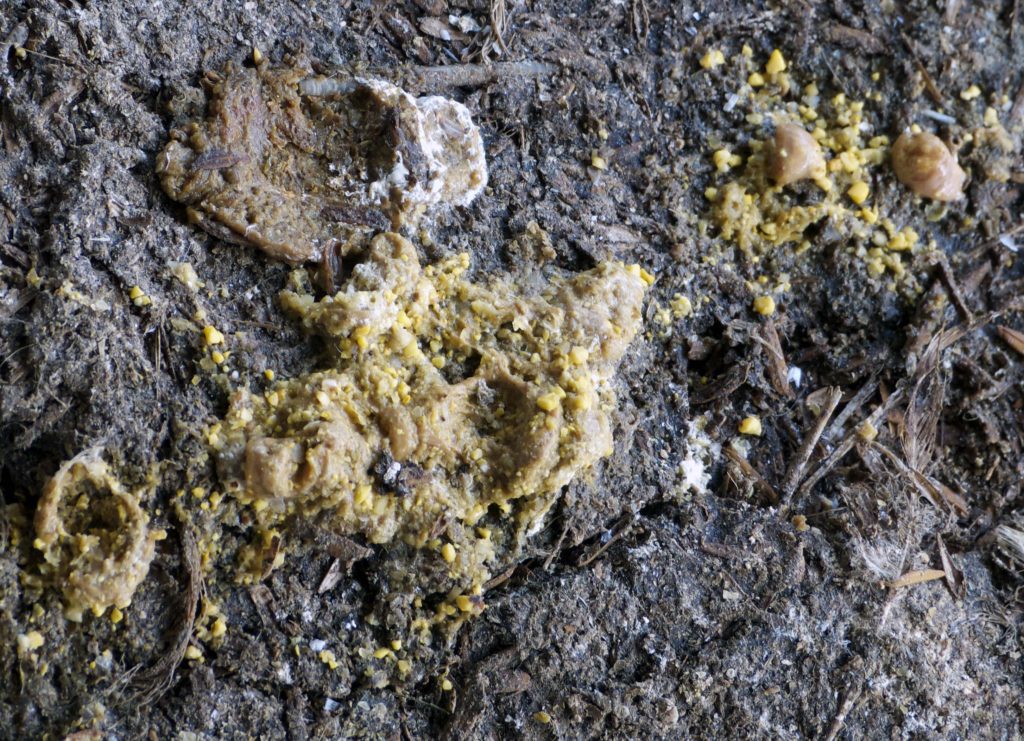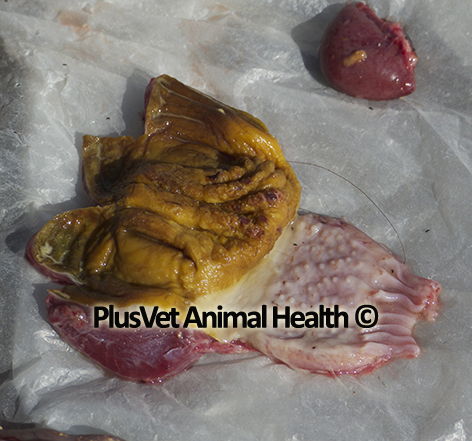20 Jun Undigested feed in broiler droppings, a serious problem for productivity

The presence of undigested feed in droppings of broilers, also known as “feed passage”, is a fairly common problem in broiler farms. It is an evidence that digestive health is not adequate and a serious loss of productivity, leading to deficient growth and poor feed conversion rate. Economic losses are huge in major outbreaks.
This article describes the main reasons for feed passage, focusing on dysbacteriosis as it is one of the leading causes, and suggests possible strategies of prevention.
SIGNS OF FEED PASSAGE
- Droppings lose their shape and the characteristic uric acid white cover.
- Droppings contain undigested feed visible to the naked eyes and have yellow/orange color. Sometimes they are watery.
- Birds are poorly pigmented and lack of uniformity.
WHEN CAN UNDIGESTED FEED BE OBSERVED?
Feed passage is not a disease per se but a general term. It can be observed during the course of different diseases (Butcher et al, 2011), mainly those that cause lesions in the tissues of digestive system or that affect the composition of intestinal flora.
- Infectious diseases of digestive system
- Bacterial and viral diseases affecting proventriculus and gizzard; necrotic enteritis; coccidiosis; intestinal parasites; infections by reovirus.
- Dysbacteriosis, leading cause for feed passage.
- Mycotoxicosis
Different types of mycotoxins affect the functioning of the digestive system, hindering proper digestion of feed. In fact, some major feed passage outbreaks have been associated to poor grain quality. For example,- Ochratoxins increase intestinal fragility (Albassam et al, 1987)
- Aflatoxins decrease bile secretion, impairing feed digestion and absorption. (Newberne et al, 1969)
- Trichothecenes cause erosions to proventriculus and gizzard (Hoer at al, 1982). Lesions in proventriculus affect the secretion of hydrochloric acid and erosions in gizzard worsen the process of feed grinding.
- Nutritional alterations
- Trypsin inhibitors present in soybean meal have been directly linked to feed passage outbreaks (Ruiz, N 2012). Safe levels < 3 mg/g.
- Antinutritional factors (gizzerozine, biogenic amines) and some vitamin deficiencies cause gizzard erosions, worsening the process of feed grinding.
- Rancid fats are claimed by some authors as a common cause of feed passage, but many other researchers state that feeding broilers with of high peroxide value fats does not produce significant lesions in the digestive system (Choque et al, 2007; Baucells et al, 2008; McGill et al, 2011).
DYSBACTERIOSIS, ONE OF THE LEADING CAUSES OF FEED PASSAGE
Dysbacteriosis (also called dysbiosis, feed passage syndrome, wet litter syndrome, unspecific enteritis and other names) is a sudden change in the intestinal microbiota. This alteration can be both in the number of bacteria and in the composition of the flora (Francesch, 2005).
Main signs:
- Undigested feed in droppings (as described above).
- Wet litter.
- Feed intake stable for some days (it does not increase with time as it should).
- Occasionally, selective feeding.
- Increased water/feed ratio.
- Inflammation and congestion of intestines.
- Thin, transparent, fragile intestinal wall.
- Orange mucus in intestine.
- Sometimes, lesions in gizzard can be observed.
When birds are reared on bedding (not on cages or nets), there exist side effects such as pododermatitis (foot pad lesions), breast blisters, more bacteremia and thus conditions such as femoral head necrosis and lameness.
In many occasions dysbacteriosis is accompanied by lesions in gizzard. The reason for this phenomenon is not known exactly, but could be explained by the investigations of some researchers that link increased occurrence of gizzard erosions to flora imbalance, specially to higher Clostridium counts, in some parts of digestive tract (Novoa-garrido et al, 2007).

Pattern of the disease
Dysbacteriosis is commonly observed after 21 days of age, sometimes as early as 15 days of age, in commercial broiler chicken flocks around the world. In Europe, as a consequence of ban of AGP, its occurrence has increased in recent years (Teirlynk et al, 2011).
The most common pattern is the following: feces look good until day 12th. Around day 15th, feces are wet, In the following days, droppings first show discharges of orange mucosa and later, around day 25th, pieces of undigested feed appear (Barragan, 2010).
Causes of the disease involve two or more of the following factors:
- Feeding errors and substantial dietary changes (i.e. change from a low protein diet to high protein), low quality feed components and inadequate feed hygiene.
- Presence of feed components that are not digestible enough and that are substrate for pathogenic microorganisms.
- Poor management or environment.
- Bad hygiene in the farm.
- Subclinical coccidiosis.
- Antibiotic abuse.
- Stress.
Confirmation of the diagnose
Confirm the presence of the pathological signs described above by necropsy of some broilers. Then treat with antibiotics and monitor results:
- If there is an improvement, the disease it’s likely to be dysbacteriosis (a professional veterinarian is needed to choose the right treatment and confirm any diagnosis).
- If there is not improvement, the problem might be related to virus, mycotoxins, biogenic amines or rancid fats. (a professional veterinarian is needed to choose the right treatment and confirm any diagnosis).
Prevention
The first target should be improving digestive health during the period of risk for dysbacteriosis, that is, as discussed above, from day 12th until day 30th. This period is the most overlooked by veterinarians and feed nutritionists, who normally focus on the first week of life and on the finisher stage.
During days 12th to 30th, it is necessary to
- Improve the quality of feed ingredients to avoid undigested feed to be the substrate of pathogenic microorganisms (pay attention to viscosity of cereals, soy and fat quality). Add exogenous enzymes if necessary.
- Use natural products that help to maintain and restore balance of intestinal flora.
- Add a effective mycotoxins binder (such as PlusBind© or PlusBind Bio©).
- Check water quality and water microbiology.
- Check the presence of sub-clinical coccidiosis. Implement suitable anti-coccidial programs.
- Review management programs to minimize stress and improve hygiene of the farm.
USE OF PLANT EXTRACTS TO MAINTAIN A HEALTHY GUT
As mentioned above, the main situations in which feed passage occurs is either when there are erosions on the tissues of gut that impair its functioning or when there is intestinal flora imbalance. Plant extracts can be used to
- Restore or maintain the integrity of digestive tissues
- Immunity: some phytochemicals, such as some compounds contained in garlic extract, are able to stimulate local gut immunity (Ota et al, 2012).
- Antioxidant compounds, such as those contained in marjoram or cinnamon, are beneficial against intestinal inflammation.
- Improve feed digestibility: Sweet bay induces a higher secretion of bile acids; cinnamon stimulates the secretion of digestive enzymes. Improved digestion means that there are less substrates for pathogenic microorganisms to grow.
- Direct action on tissues: Chicory is able to modify the morphology of the intestinal epithelium, by increasing the villus length and crypt depth, and thus amplifying the absorptive surface and and maintaining a healthy intestine.
- Restore or maintain balance of intestinal microbiota
- Microbiocide: cinnamon, marjoram or garlic have proven to be natural bactericides are able to reduce the load of pathogenic microorganisms in case of imbalance. Unlike antibiotics, they do not exert a germicidal action which can reduce the numbers of useful microbes.
- Prebiotics: chicory feeds beneficial lactic acid bacteria and promotes their growth exponentially.
Best results to maintain digestive health are obtained when plant extracts are used from day one ensuring that the animal arrives to the critical time for dysbacteriosis with an optimal development of the digestive system and a healthy intestinal flora.
Products of choice
GrowthPlus© is added to feed to maintain and improve digestive health. It is formulated with synergistic ingredients:
- Bactericidal and fungicidal plant extracts, combined with organic acids for better effectiveness, that reduce the number of pathogenic microbes in the digestive system.
- Plant extracts with prebiotic effect, that promote the growth of beneficial bacteria in the gut.
- Immunostimulant and antioxidant plant extracts.
- Silicates with mycotoxin binding function.
It is especially useful in cases of gizzard diseases, necrotic enteritis, feed passage and other enteritis. It is also used as a natural growth promoter and to replace antibiotic growth promoters.
PlusProtect Digestive© is intended for digestive health in birds and rabbits of all ages. It is formulated with synergistic ingredients:
- Essential oils with bactericidal and fungicidal activity
- Plant extracts with prebiotic effect.
- Immunostimulant and antioxidant essential oils
PlusProtect Digestive© is useful to improve gut health in the following cases:
- Candidiasis in beak, crop and gizzard
- Bacterial infections in gizzard. In severe cases, it is better to give together with our PlusBind© line (mycotoxin binders)
- Bacterial infections in the intestines (necrotic enteritis; E.coli; Salmonella sp.)
- General digestive imbalances, such as feed passage.
PlusBind© is a mixture of carefully selected silicates intended for the prevention of diseases and productivity losses related to the presence of all types of mycotoxins. It is indicated in poultry, pigs, aquaculture and ruminants.
The silicates present in PlusBind© have a highly expandable molecular structure. This characteristic gives the product a wide surface available for the adsorption of mycotoxins and therefore allows a high effectiveness at lower doses (0.5-1 kg per ton of feed).
Do not miss any of our articles!
Subscribe to our monthly newsletter

Certain health statements may not be applicable in your region.

